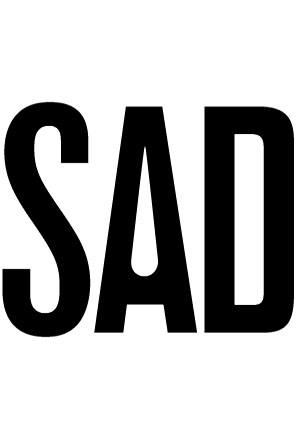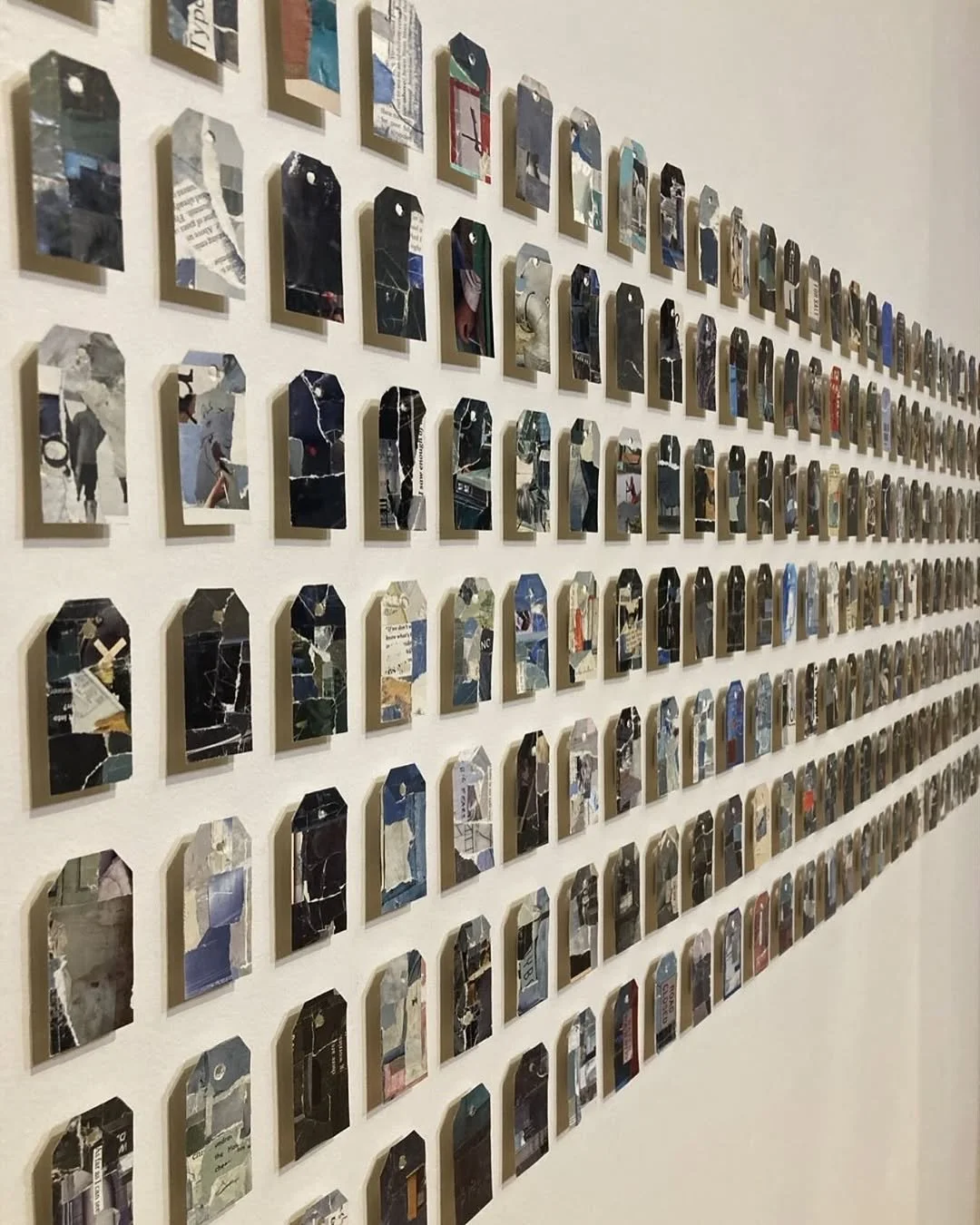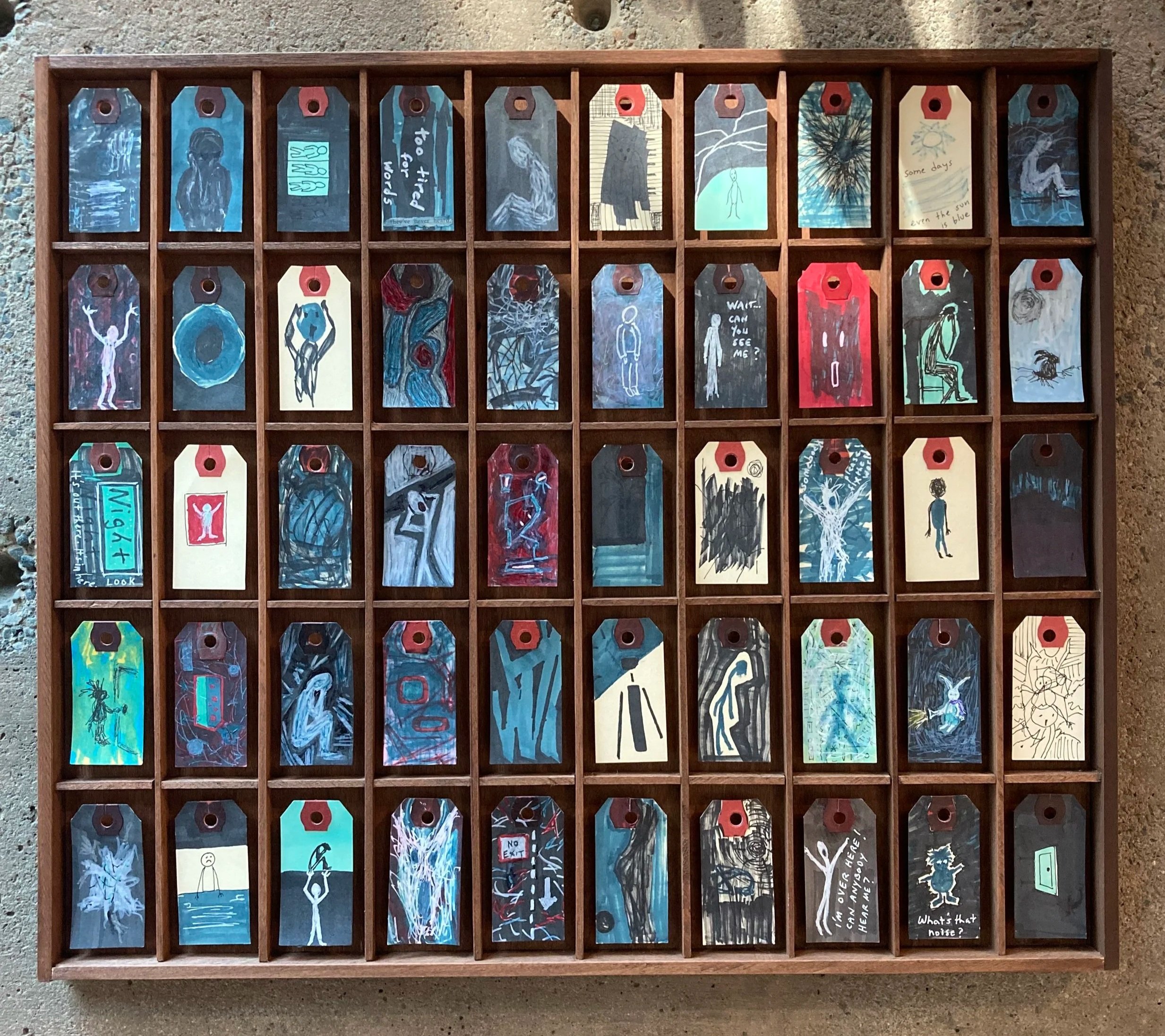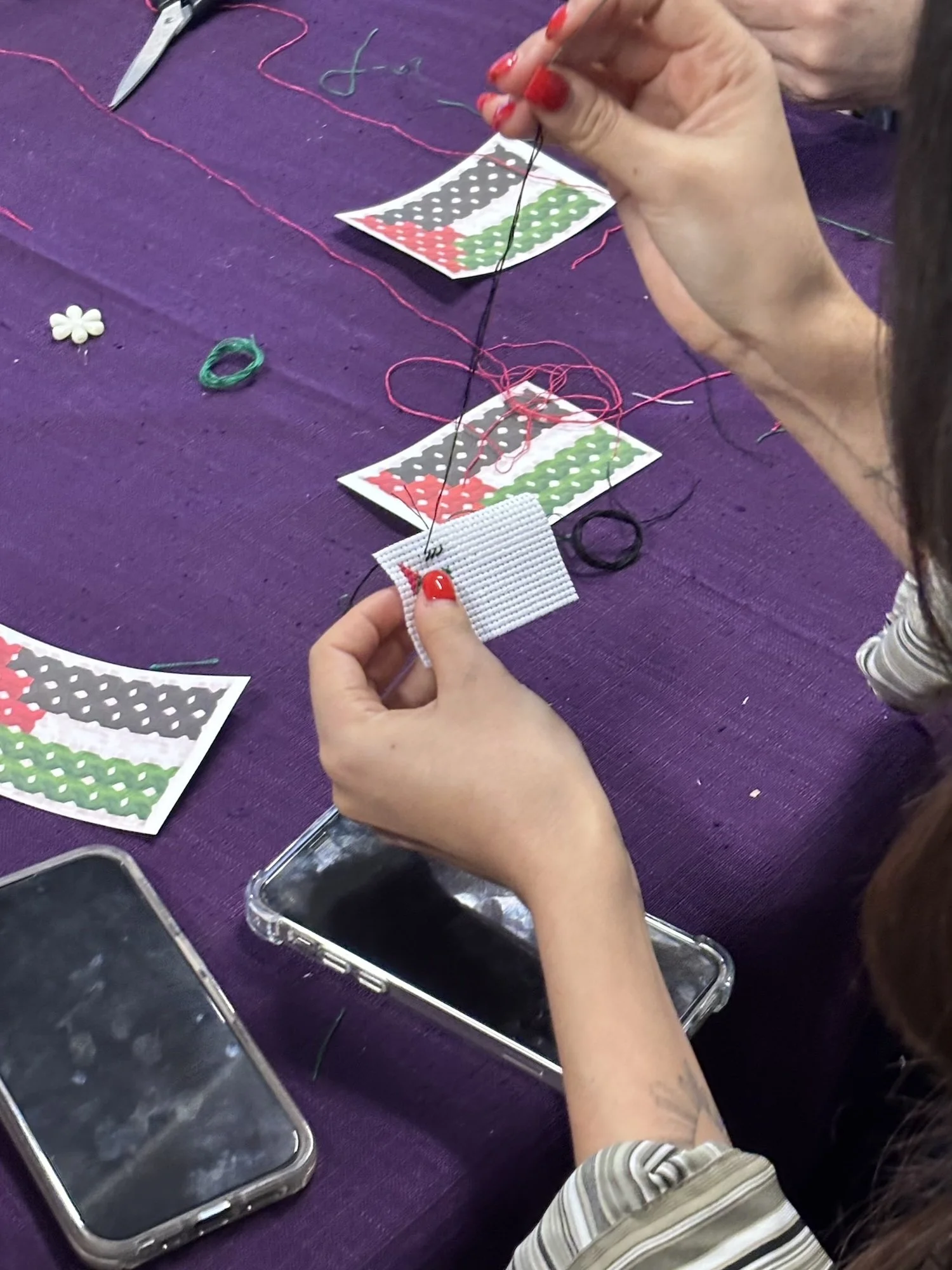Collaging Through/With Complex Trauma: In Conversation with Seema Shah
/seema Shah’s exhibit ‘Missing Pieces’ courtesy of outsiders and others.
Art that makes you linger a little longer, that draws your attention to a quiet detail you might have missed at first glance is a rare gift. Missing Pieces, Seema Shah’s solo art show at Outsiders and Others from August 2 to 30, is one such gift. Seema is a collage artist and writer based in Vancouver, BC.
I first met her as my editor on the Off the Map anthology. It was a pleasure to work with her again for this interview. In our conversation, I spoke with Seema about her process, the role of narrative and how the passage of time and lived experience shape her art.
exhibit photo courtesy of outsiders and others.
The show features a collection of 366 miniature collages on shipping tags, each just 2 ¾” x 1 ⅜”, created daily throughout 2024, alongside earlier works on tags and vintage envelopes from 2014. The repetition of form, the layering of paper and the juxtaposition of image and text create a language that, when viewed together, hums with the ongoing work of living and the gift of small surprises along the way.
As a fellow survivor and emerging collage artist, I am drawn to how Seema’s work organically blends both the exhaustion of complex trauma and the wondrous world of collaging. Missing Pieces invites viewers to look closely and spend time with the delicate, tiny and mighty collage pieces on display.
“I liken my collages to dreams–subconscious expressions filled with multiple layers and meanings, speaking the language of metaphors and symbols. Much can be learned about oneself, but personal meaning is not always obvious, immediate or fully understood. ”
artist seema shah outside of outsiders and others. photo courtesy of Yuri Arajs.
Adishi Gupta: Where did you first come across the idea of working with shipping tags? What about this idea spoke to you?
Seema Shah: I first came across the idea on social media at the end of 2013. I saw an artist post that their 2014 New Year’s resolution was to write a positive affirmation on a shipping tag every day. The idea of working with shipping tags spoke to me because it felt like the perfect fit for me at that point in my life.
A worsening of chronic fatigue syndrome left me without the concentration or energy to write, which had been my main focus at the time. I searched for another creative outlet–one that felt manageable and that I could do from bed.
Though I modified the specifics, I stuck with the idea of working with shipping tags: my New Year’s resolution for 2014 was to do something–anything–creative on a shipping tag every day that year. The small size of the tags and giving myself permission to do whatever I was able to on a given day–even just a scribble–was key to successfully following through on my resolution.
I replicated the one-year shipping tag project in 2024, altering the parameters slightly. I wanted a break from creating work “for” something and this seemed like an ideal way to carve out time for my personal art practice.
AG: It is wonderful to see the different ways you create a narrative through your collages. Sometimes it is through abstract imagery and doodles, sometimes it is through found words and at other times, it is through found poetry. Can you describe your process of bringing disparate pieces together to form tiny visual stories?
SS: I work intuitively, letting the process guide me, instead of me trying to guide it. I search for images, colours and words that speak to me in the moment, even if it’s not clear to me why. Spontaneous associations and unexpected juxtapositions bring subconscious and embodied “knowing” to the surface, often through the language of metaphor and symbolic imagery. Sometimes I’m inspired to also draw or use other media.
When I use text, it has to happen naturally and feel “right.” Sometimes the work feels more powerful without any text. When I do include text, what’s key is that the words add to the meaning and/or emotional valence of a piece. Quite often, words that feel “right” just show up in the scraps I’m piecing together.
Figuring out which pieces are part of the tiny visual story that’s unfolding, and how they fit together, can take hours. There’s a spontaneous aspect to the process, but there’s also a lot of experimenting and rearranging. For me, emotion, meaning and aesthetics are all important considerations as the narrative takes shape.
photo courtesy of outsiders and others.
AG: One of your tag collages from March 16, 2024, asks the question, “How do you know where to dig? What do you look for?” Where do you dig for inspiration, memories, image and text sources, both as a collagist and as a writer?
SS: As a collagist, I rely heavily on National Geographic magazines for images and text. I like the weight and texture of the paper, the visuals, as well as the look of the text. Also, because of the subjects they cover, the articles inherently include a lot of interesting phrases that lend themselves to metaphor.
While I work on a collage, my inner world becomes the focus and the outer world is shut out. Spontaneous associations and unexpected juxtapositions of image and text are a way to tap into subconscious and embodied “knowing,” where disconnected traumatic memories live.
Though my writing is also rooted in the personal, I write creative nonfiction about specific experiences. Ideas come from journal entries, photographs and conscious remembrances. The process is still intuitive and one of self-discovery, but collage allows me to dig deeper.
AG: What was your experience creating these collages on shipping tags and envelopes? How did it differ or stay the same in 2014 and 2024?
SS: My 2014 shipping tag project was the start of my journey as a collage artist. I began working with the medium organically, creating collages intermittently throughout the year. When I undertook my 2024 shipping tag project, I was well into my journey as a collage artist. There was more intent than in 2014, with the focus on collage and the goal of creating a ‘piece’ every day.
Despite these differences, the creative process behind my 2014 and 2024 collages was the same. The collages from both years are consistent with my voice and style, but I feel the 2024 collages show an evolution in the style and complexity of my work, and reflect a deeper connection to my artistic voice. Though some specifics vary, the 2014 and 2024 collages convey a similar feel and are steeped in themes related to complex trauma, including fragmentation, disconnection, and isolation.
AG: As someone also living with complex trauma, I continue to find solace in the fragmentation inherent in the medium. As an emerging collagist myself, I have come to appreciate how the act of assembling mismatched or cast-off elements into something whole can feel both grounding and affirming. Do you find that the fragmented nature of collage mirrors or supports the way you process the world? How does working with such a medium affect your sense of self or understanding of your own story?
SS: For me, the fragmented nature of collage mirrors my inner world–the fragmentation of sense of self and of memories. Due to the nature of my creative process, assembling cast-off elements to create a collage is a way to externalize and better understand cast-off elements from within, helping to piece together a more cohesive self-narrative. I liken my collages to dreams–subconscious expressions filled with multiple layers and meanings, speaking the language of metaphors and symbols. Much can be learned about oneself, but personal meaning is not always obvious, immediate or fully understood.
Photo courtesy of outsiders and others.
Seema Shah’s solo exhibit, Missing Pieces, runs from August 2-30, 2025. There will be an Artist Talk and Exhibition Tour on August 16 at 2 p.m. that is free admission to the public. Shah will also be hosting a collage workshop on August 23 at 2 p.m.. The solo show and corresponding events will be held at Outsiders and Others, a non-profit arts society. To register for the collage workshop or find out more about the exhibit, visit Outsiders and Others.
Adishi Gupta (she/her) is a freelance consultant, writer and emerging visual artist based in Vancouver, BC. Her writing and art have appeared in various national and international publications including Off The Map, Geist, The Chestnut Review (2026), The Swaddle, among others. Memoirs, poetry, collages, nature walks, sky gazing, anti-racist community work and accessible spaces are some of her many favourite things. In everything she does, she hopes to offer up something intriguing, moving and transformative for the community. Follow her work on Instagram at Found Art by Adishi or on her soon to be published website adishigupta.com.
Seema Shah is a self-taught visual artist and writer based in Vancouver, BC. She was a recipient of The Beaumont Studios’ Artist To Watch Award 2022 and a highly commended artist in the 2022 & 2023 Contemporary Collage Magazine Awards. Seema first began showing her artwork publicly in 2017. Since that time, her artwork has been shown and collected nationally and internationally. Her miniature collages have been exhibited in two dollhouse galleries in the UK, The House of Smalls and Small House Gallery, where she had a solo show in 2024. You can see more of her art at www.seemashahart.com and on Instagram at @tellingitslant.
Seema’s writing has been published in literary journals and anthologies, shortlisted for the Canadian Lesbian & Gay Archives’ Narrative Essay Contest and the Surrey International Writing Conference Contest, and longlisted for the Susan Crean Award for Nonfiction 2023. She co-edited Off the Map: Vancouver Writers with Lived Experience of Mental Health Issues with Betsy Warland and Kate Bird, and was also a contributor to this anthology, which was published by Bell Press in May 2025.










